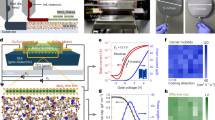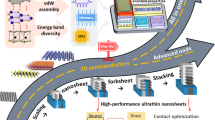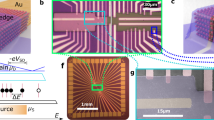Abstract
Work from several laboratories has shown that metal nanofilaments cause problems in some molecular electronics testbeds. A new testbed for exploring the electrical properties of single molecules has been developed to eliminate the possibility of metal nanofilament formation and to ensure that molecular effects are measured. This metal-free system uses single-crystal silicon and single-walled carbon nanotubes as electrodes for the molecular monolayer. A direct Si–arylcarbon grafting method is used. Use of this structure with π-conjugated organic molecules resulted in a hysteresis loop with current–voltage measurements that are useful for an electronic memory device. The memory is non-volatile for more than 3 days, non-destructive for more than 1,000 reading operations and capable of more than 1,000 write–erase cycles before device breakdown. Devices without π-conjugated molecules (Si–H surface only) or with long-chain alkyl-bearing molecules produced no hysteresis, indicating that the observed memory effect is molecularly relevant.
This is a preview of subscription content, access via your institution
Access options
Subscribe to this journal
Receive 12 print issues and online access
$259.00 per year
only $21.58 per issue
Buy this article
- Purchase on Springer Link
- Instant access to full article PDF
Prices may be subject to local taxes which are calculated during checkout






Similar content being viewed by others
References
Tour, J. M. Molecular Electronics: Commercial Insights, Chemistry, Devices, Architecture and Programming (World Scientific, River Edge, New Jersey, 2003).
Blum, A. S. et al. Molecularly inherent voltage-controlled conductance switching. Nature Mater. 4, 167–172 (2005).
Donhauser, Z. J. et al. Conductance switching in single molecules through conformational changes. Science 292, 2303–2307 (2001).
Chen, J., Reed, M. A., Rawlett, A. M. & Tour, J. M. Large on-off ratios and negative differential resistance in a molecular electronic device. Science 286, 1550–1552 (1999).
Ramachandran, G. K. et al. A bond-fluctuation mechanism for stochastic switching in wired molecules. Science 300, 1413–1416 (2003).
Collier, C. P. et al. Electronically configurable molecular-based logic gates. Science 285, 391–394 (1999).
Coulter, S. K., Schwartz, M. P. & Hamers, R. J. Sulfur atoms as tethers for selective attachment of aromatic molecules to silicon(001) surfaces. J. Phys. Chem. B 105, 3079–3087 (2001).
Guisinger, N. P., Basu, R., Greene, M. E., Baluch, A. S. & Hersam, M. C. Observed suppression of room temperature negative differential resistance in organic monolayers on Si(100). Nanotechology 15, S452–S458 (2004).
Piva, P. G. et al. Field regulation of single-molecule conductivity by a charged surface atom. Nature 435, 658–661 (2005).
Seminario, J. M., Zacarias, A. G. & Tour, J. M. Theoretical study of a molecular resonant tunneling diode. J. Am. Chem. Soc. 122, 3015–3020 (2000).
Dameron, A. A., Ciszek, J. W., Tour, J. M. & Weiss, P. S. Effects of hindered internal rotation on packing and conductance of self-assembled monolayers. J. Phys. Chem. B 108, 16761–16767 (2004).
Selzer, Y. et al. Effect of local environment on molecular conduction: isolated molecule versus self-assembled monolayer. Nano Lett. 5, 61–65 (2005).
Selzer, Y., Carbassi, M. A., Mayer, T. S. & Allara, D. L. Temperature effects on conduction through a molecular junction. Nanotechnology 15, S483–S488 (2004).
Newman, C. R. et al. Introduction to organic thin film transistors and design of n-channel organic semiconductors. Chem. Mater. 16, 4436–4451 (2004).
Fisher, G. L. et al. Bond insertion, complexation, and penetration pathways of vapor-deposited aluminum atoms with HO- and CH3O-terminated organic monolayers. J. Am. Chem. Soc. 124, 5528–5541 (2002).
De Boer, B. et al. Metallic contact formation for molecular electronics: interactions between vapor-deposited metals and self-assembled monolayers of conjugated mono- and dithiols. Langmuir 20, 1539–1542 (2004).
Smith, R. K., Lewis, P. A. & Weiss, P. S. Patterning self-assembled monolayers. Prog. Surf. Sci. 75, 1–68 (2004).
Haag, R., Rampi, M. A., Holmlin, R. E. & Whiteside, G. M. Electrical breakdown of aliphatic and aromatic self-assembled monolayers used as nanometer-thick organic dielectrics. J. Am. Chem. Soc. 121, 7895–7906 (1999).
James, D. K. & Tour, J. M. Electrical measurements in molecular electronics. Chem. Mater. 16, 4423–4435 (2004).
Anaya, A., Korotkov, A. L., Bowman, M., Waddel, J. & Davidovic, D. Nanometer-scale metallic grains connected with atomic-scale conductors. J. Appl. Phys. 93, 3501–3508 (2003).
Lau, C. N., Stewart, D. R., Williams, R. S. & Bockrath, M. Direct observation of nanoscale switching centers in metal/molecule/metal structures. Nano Lett. 4, 569–572 (2004).
Stewart, M. P. et al. Direct covalent grafting of conjugated molecules onto Si, GaAs, and Pd surfaces from aryldiazonium salts. J. Am. Chem. Soc. 126, 370–378 (2004).
Dyke, C. A. & Tour, J. M. Covalent functionalization of single-walled carbon nanotubes for materials applications. J. Phys. Chem. A 108, 11151–11159 (2005).
Mohney, S. E. et al. Measuring the specific contact resistance of contacts to semiconductor nanowires. Solid-State Electron. 49, 227–232 (2005).
Chiang, I. W. et al. Purification and characterization of single-wall carbon nanotubes (SWNTs) obtained from the gas-phase decomposition of CO (HiPco process). J. Phys. Chem. B 105, 8297–8301 (2001).
Fan, F. -R. F. et al. Charge transport through self-assembled monolayers of compounds of interest in molecular electronics. J. Am. Chem. Soc. 124, 5550–5560 (2002).
Pinson, J. & Podvorica, F. Attachment of organic layers to conductive or semiconductive surfaces by reduction of diazonium salts. Chem. Soc. Rev. 34, 429–439 (2005).
Kim, H. J. et al. A process integration of high-performance 64-kb MRAM. IEEE Trans. Magn. 39, 2851–2853 (2003).
Salomon, A. et al. Comparison of electronic transport measurements on organic molecules. Adv. Mater. 15, 1881–1890 (2003).
Wang, W., Lee, T., Kretzschmar, I. & Reed, M. A. Inelastic electron tunneling spectroscopy of an alkanedithiol self-assembled monolayer. Nano Lett. 4, 643–646 (2004).
Rueckes, T. et al. Carbon nanotube-based nonvolatile random access memory for molecular computing. Science 289, 94–97 (2000).
Flatt, A. K., Chen, B. & Tour, J. M. Fabrication of carbon nanotube-molecule-silicon junctions. J. Am. Chem. Soc. 127, 8918–8919 (2005).
Kosynkin, D. V. & Tour, J. M. Phenylene ethynylene diazonium salts as potential self-assembling molecular wires. Org. Lett. 3, 993–995 (2001).
Flatt, A. K. & Tour, J. M. Synthesis of thiol substituted oligoanilines for molecular device candidates. Tetrahedron Lett. 44, 6699–6702 (2003).
Chen, F. et al. A molecular switch based on potential-induced changes of oxidation state. Nano Lett. 5, 503–506 (2005).
Acknowledgements
This work was supported by the Defense Advanced Research Projects Agency through the Air Force Office of Scientific Research.
Author information
Authors and Affiliations
Corresponding author
Ethics declarations
Competing interests
The authors declare no competing financial interests.
Supplementary information
Supplementary Information
Supplementary information and figures (PDF 47 kb)
Rights and permissions
About this article
Cite this article
He, J., Chen, B., Flatt, A. et al. Metal-free silicon–molecule–nanotube testbed and memory device. Nature Mater 5, 63–68 (2006). https://doi.org/10.1038/nmat1526
Received:
Accepted:
Published:
Issue Date:
DOI: https://doi.org/10.1038/nmat1526
This article is cited by
-
Interplay of structural chirality, electron spin and topological orbital in chiral molecular spin valves
Nature Communications (2023)
-
Role of redox centre in charge transport investigated by novel self-assembled conjugated polymer molecular junctions
Nature Communications (2015)
-
Molecular memory with atomically smooth graphene contacts
Nanoscale Research Letters (2013)
-
Photo-switchable molecular monolayer anchored between highly transparent and flexible graphene electrodes
Nature Communications (2013)
-
Molecular electronics in silico
Applied Physics A (2008)



